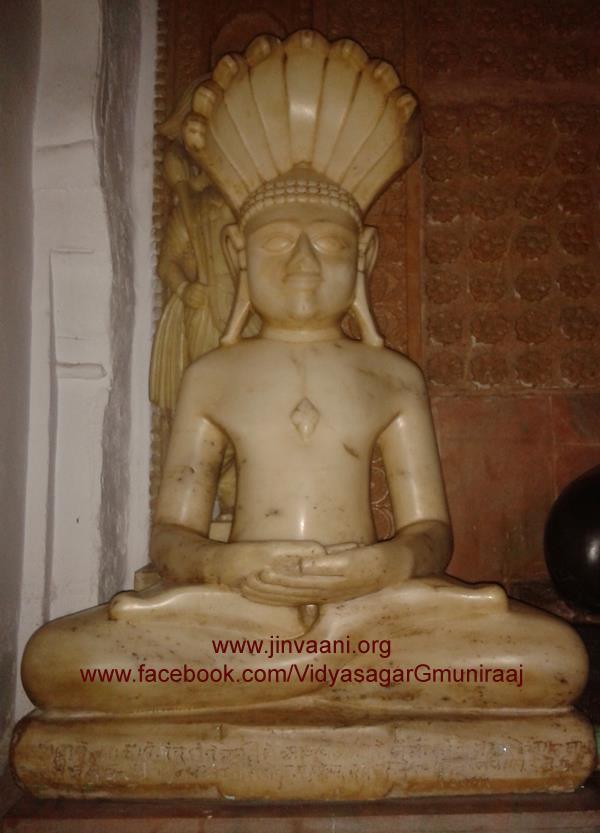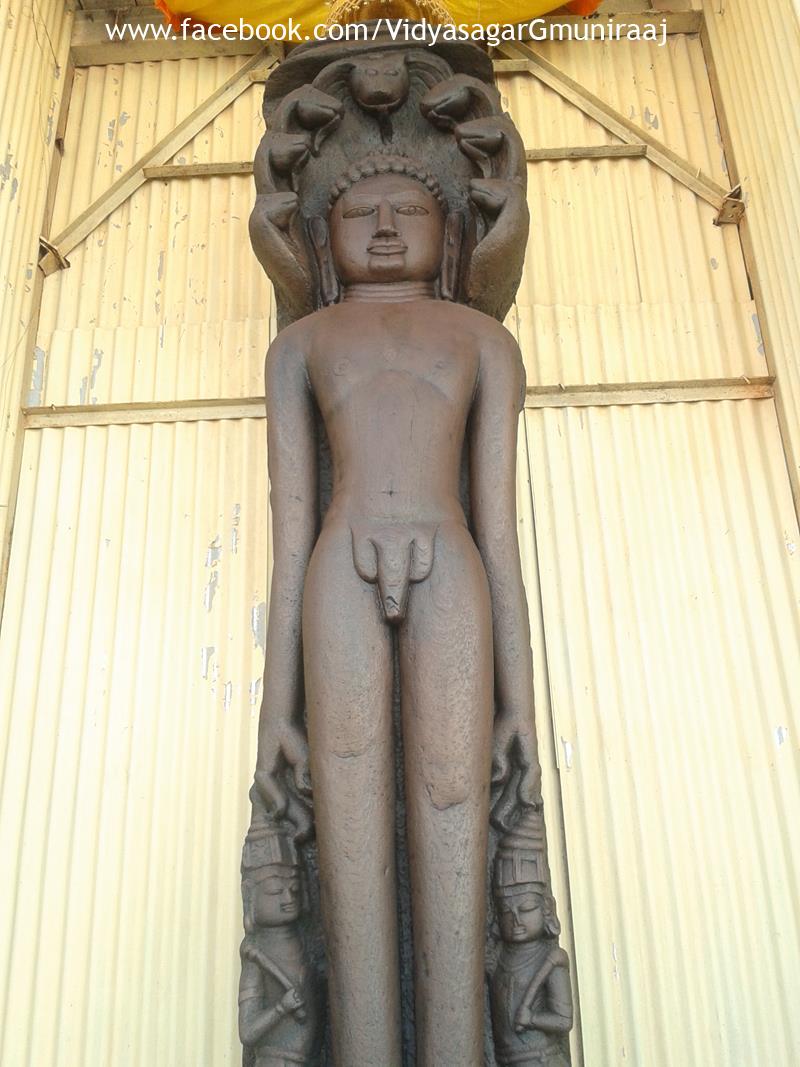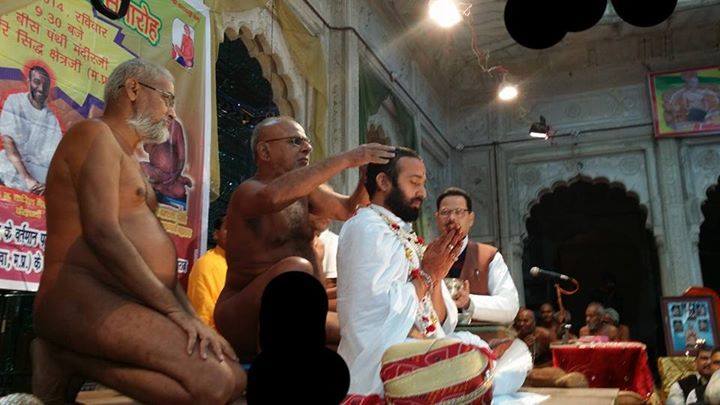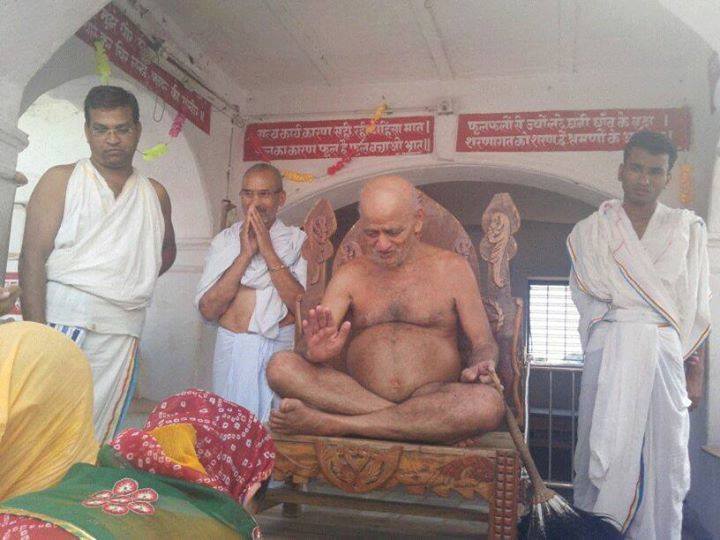Update
 Source: © Facebook
Source: © Facebook
#UPDATE #ACHARYA #VIDYASAGARJI #VIHAR ❖ आचार्य विद्यासागर जी महाराज का मगंल विहार आज 1:40 पर रेहली की तरफ हुआ । आचार्य श्री का गढ़ाकोटा पंच कल्याणक मेंजाना सम्भव दिख रहा हैं, आज रात्रि विश्राम: सिंहपुर । रेहली में विराजमान पूज्य मुनिश्री पवित्रसागर जी,मुनिश्री प्रयोगसागर जी को अगवानी करने एवं चरण वंदना करने का मिल सकता है!! ❖
--- ♫ www.jinvaani.org @ Jainism' e-Storehouse ---
 Source: © Facebook
Source: © Facebook
❖ The Nigganthas tradition
Lord Rishabha (ऋषभ) is regarded as the first and Lord Vardhamana (Mahavira, महावीर) is regarded the last Tirthankar to attain enlightenment (599-527 BCE) of the present six-cycle period of Jain chronology. Before Mahavira, Jain tradition was known by many names such as
1. Sraman
2. Nigganthas/nirgranthas
3. Arhat
4. Vatarshana Muni
5. Vratya
They were called Nigganthas/Nirgranthas because they were detached and free from passions.
Bhikshu Dharmananda Kosambi has said; “In Tripitakas, there is a mention in several places about Nigganthas-Jains. From this it is clear that the Nigganthas tradition was in existence many years before Buddha. It is mentioned in the Anguttara Nikaya that one “Bappa” named Shakya (belonging to the clan of Shakyas in which Buddha was born) was a lay follower (Sravaka) of the Nigganthas (Jain). In the same Sutta’s Atthahatha it is also said that this “Bappa” was an uncle of Buddha."
It may be mentioned here that Nigganthas means unattached, without possessions, an ancient name for the Jain community.
Buddhist texts refer to the existence of large numbers of Nigganthas (unattached ones) who followed the Samvara.
Prof. Jacobi notes:
“The Nigganthas are frequently mentioned by the Buddhists, even in the oldest part of the Pitakas. But I have not yet met with a distinct mention of the Buddha in any of the old Jain Sutras. As it is inconsistent with our assumption of a contemporaneous origin of both creeds, we are driven to the conclusion that the Nigganthas were not a newly founded sect of Buddha’s time. This seems to have been the opinion of the Pitakas too, for we find no indication to the contrary in them.” (“On Mahavira and His Predecessors” in the Indian Antiquary, IX, 1880 158-163)
--- ♫ www.jinvaani.org @ Jainism' e-Storehouse ---
Update
 Source: © Facebook
Source: © Facebook
❖ Antiquity of Jainism-- Lord MAHAVIRA is not the founder of Jainism. Since Gautama Buddha, founder of Buddhism, belonged to the same region of Magadha as MAHAVIRA - the 24th Tirthankar of Jainism, and because both were contemporaries, it was assumed erroneously that Jainism was contemporary of Buddhism or was an off shoot of Buddhism.
It is now accepted that Jainism is not only older than Buddhism but it has got its roots going deep into the antiquity in pre-Aryan and pre-Vedic times. Herman Jacobi, states in his article on Jainism in Encyclopaedia of Religion and Ethics (Vol. II, pp. 465-74):
“Notwithstanding the radical difference in their philosophical notions, Jainism and Buddhism being outside the place of Brahmanism, present resemblances in outward appearance, so that even Indian writers occasionally have confounded them. It is therefore not to be wondered that some European scholars who became acquainted with Jainism through inadequate samples of Jain literature easily persuaded themselves that it was an outcome of Buddhism. But it has since been proved that their theory is wrong.”
According to Jain beliefs, the universe was never created, nor will it ever cease to exist. Time is divided into Utsarpinis (Progressive Time Cycle) and Avsarpinis (Regressive Time Cycle). An Utsarpinis and an Avsarpinis constitute one Time Cycle (Kalchakra). Every Utsarpinis and Avsarpinis is divided into six unequal periods known
as Eras. During the Utsarpinis half cycle, humanity develops from its worst to its best. During the Avsarpinis half-cycle, these notions deteriorate from the best to the worst. Jains believe we are currently in the fifth Era of the Avsarpinis phase, with approximately 19,000 years until the next Era. After this Avsarpinis phase, the Utsarpinis phase will begin, continuing the infinite repetition of the Kalchakra.
--- ♫ www.jinvaani.org @ Jainism' e-Storehouse ---
News in Hindi
 Source: © Facebook
Source: © Facebook
❖ The Arhatas & Vatarshana Munis
They were called Arhatas /Arhantas (worthy of Worship) because they were lived virtuous life. Several authors contend that during the time when Vedas were taking shape, a number of elements, which had subsequently entered in Jain religion, were already known. This is confirmed by the fact that monks are called arahans or arahatas in Rigveda and Atharva Veda.
Rishabhadeva has been described as the incarnation of Vishnu for the establishment of the religion of Vatarashana Munis. “These Munis appeared pisanga (Pingalavarna) because they were indifferent to bathing, even though they were Maladhari that is unclean, due to sweat etc. They used to remain silent and looked wild owing to their meditative practices. By controlling breathing (by means of pranayama) they used to attain to godhood. The mortal world could only see their external bodies, not their inner soul”:
मुनयो वातरशना पिशंगा वसते मला: वातस्यानु थ्ांजिं यंपत यद्दैत्रासो अपवक्षत्: उन्मपतदा मौनयेन वातां िंा तास्थैमा वयम् शरीरे दस्माकं युयं मतांसो अपभ िश्यथ (ऋग््वेद, १०, १३६, २)
Dr. Hiralal Jain has explained” They are Munis and their ways of renunciation, silence and non- attachment distinguish them from the Rishi tradition. But a new word Vatarashana is connected with them. Vata means air and vashana means girdle or waistband. Therefore the meaning is air-cloth or one whose clothing is air, that is, naked. This is not a new term for the Jain tradition, and it occurs in Jina sahasranama - Thousand names for Jina- Thus: -
“According to this Vatarashana, Digvasa, Nigganthas and Digambara, all these are synonymous terms and indicate a naked or nude state, So it can be concluded that at the time of the Rigveda composition such munis were in existence who used to go about naked and who were revered as gods in the Rishi tradition and were eulogized and worshipped.
Bharatvarsha After Bharata Son Of Rishabha:
India Known As Bharatvarsha After Bharata Son Of Rishabha:
“But they have ignored other mentions in the same Purana and elsewhere about Rishabha son Bharata….For this opinion the necessary testimonials have not been adduced. Probably these cannot be anything else than the slokas quoted above. But the fact that in the same Purana it is clearly mentioned elsewhere that the name Bharatvarsha was given by Rishabha son Bharat, and that the word “ Desha” or “ Varsha” does not occur with Dushyanta’s son Bharata, does not appear to have been considered carefully by these scholars before asserting their opinion”
In the Purana it is clearly mentioned:
ऋषभो मरुदेव्याश्च ऋषभात भरतो भवेत् भरताद भारतं वषं, भरतात सुमपतस्त्वभूत्
That is “Rishabha was born to Marudevi, Bharat was born to Rishabha, Bharatvarsha (India) arose from Bharat, and Sumati arose from Bharat.”
--- ♫ www.jinvaani.org @ Jainism' e-Storehouse ---
 Source: © Facebook
Source: © Facebook
❖ ऋजुभावं आर्जवं - ऋजु मतलब सीधा और सरल भाव, मायाचारी रहित, जैसा मन में विचार हो अभिप्राय हो वैसे ही बाहर भी हो...मन, वचन और काया से एक सा हो जाना, व्यक्ति अन्दर से कुछ होता है और बहार से कुछ...आज कल तो दिखावा बहुत ज्यादा हो गया है...जीवन में उलझनें दिखावे और आडम्बर की वजह से हैं..अन्दर से कुछ और बहार से कुछ और...हर तरफ दिखावा...ये दिखावा शांति -मार्ग में सबसे बड़ा शत्रु है..जिसमे दुसरे को नीचा दिखाने की भावना रहती है..और दुसरो को प्रभावित करने के मानसिक सोच रहती है..रे बंधू ये दो दिन में विनाश जाएगी..इस सांसारिक नाम-ख्याति को छोड़ दे और भव भव में शांति देने वाली...सरल स्वभाव को ग्रहण कर...और हो जा आर्जव यानी सरल स्वभावी और निष्कपट हो जाना!
यह पुष्प सुकोमल कितना है, तन में माया कुछ शेष नही
निज अंतर का प्रभु भेद काहूँ, औस में ऋजुता का लेश नही
चिन्तन कुछ फिर संभाषण कुछ, वृत्ति कुछ की कुछ होती है
स्थिरता निज में प्रभु पाऊं जो, अंतर का कालुश धोती है
--- ♫ www.jinvaani.org @ Jainism' e-Storehouse ---
